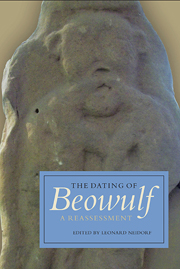Book contents
- Frontmatter
- Contents
- List of Tables
- List of Illustrations
- List of Contributors
- Acknowledgements
- Introduction
- 1 Beowulf and Language History
- 2 Germanic Legend, Scribal Errors, and Cultural Change
- 3 Names in Beowulf and Anglo-Saxon England
- 4 The Limits of Conservative Composition in Old English Poetry
- 5 The Date of Composition of Beowulf and the Evidence of Metrical Evolution
- 6 Beowulf and the Containment of Scyld in the West Saxon Royal Genealogy
- 7 History and Fiction in the Frisian Raid
- 8 ‘Give the People What They Want’: Historiography and Rhetorical History of the Dating of Beowulf Controversy
- 9 A Note on the Other Heorot
- 10 Beowulf and Conversion History
- 11 Material Monsters and Semantic Shifts
- 12 Scandals in Toronto: Kaluza's Law and Transliteration Errors
- 13 Afterword: Beowulf and Everything Else
- Index
5 - The Date of Composition of Beowulf and the Evidence of Metrical Evolution
Published online by Cambridge University Press: 05 October 2014
- Frontmatter
- Contents
- List of Tables
- List of Illustrations
- List of Contributors
- Acknowledgements
- Introduction
- 1 Beowulf and Language History
- 2 Germanic Legend, Scribal Errors, and Cultural Change
- 3 Names in Beowulf and Anglo-Saxon England
- 4 The Limits of Conservative Composition in Old English Poetry
- 5 The Date of Composition of Beowulf and the Evidence of Metrical Evolution
- 6 Beowulf and the Containment of Scyld in the West Saxon Royal Genealogy
- 7 History and Fiction in the Frisian Raid
- 8 ‘Give the People What They Want’: Historiography and Rhetorical History of the Dating of Beowulf Controversy
- 9 A Note on the Other Heorot
- 10 Beowulf and Conversion History
- 11 Material Monsters and Semantic Shifts
- 12 Scandals in Toronto: Kaluza's Law and Transliteration Errors
- 13 Afterword: Beowulf and Everything Else
- Index
Summary
Since the date of the Beowulf manuscript is widely agreed upon, the very question which prompts this volume (and the conference it derives from, and even the 1980 conference with its 1981 proceedings volume) must assume that the date of the poem may not be the same as the date of the manuscript. It is certain that there must have been a moment of first inscription for the poem, and that the time and place of that moment remains a central point of interest for students of the poem. In this essay, I will bring new evidence to bear on this venerable question, and my argument shall be that Beowulf is metrically conservative according to a variety of independent metrical criteria. Further, I will suggest that that conservatism is so varied and consistent as to strongly indicate that the original version of Beowulf must be placed among the very earliest of the longer narrative Old English poems that survive, probably in the eighth century.
Of course, it remains true, I believe, that the moment of inscription is only one of the moments of interest which might engage modern scholars of the poem. As I argued in Authors, Audiences, and Old English Verse, our focus on authorship (and on moments of authorship) may sometimes cause us to lose sight of what can be gained by also considering audience, and I proposed there two later audiences for Beowulf, one located at Alfred's Wessex court in the late ninth century, and another, sometime around the turn of the eleventh century, perhaps in Canterbury, represented most clearly by the author of Maldon.
- Type
- Chapter
- Information
- The Dating of BeowulfA Reassessment, pp. 97 - 111Publisher: Boydell & BrewerPrint publication year: 2014



